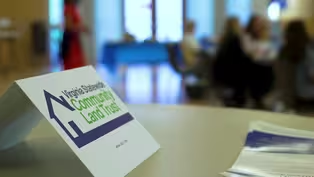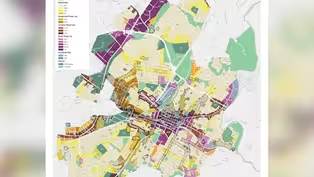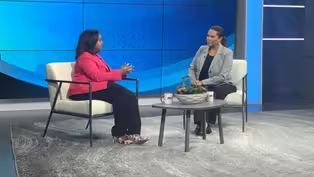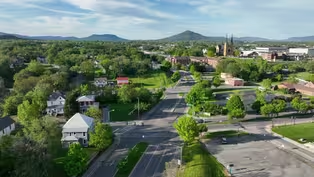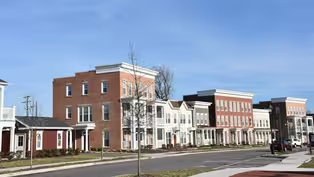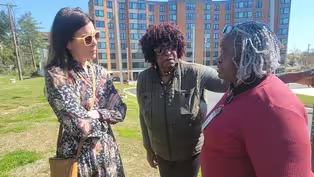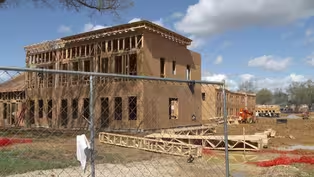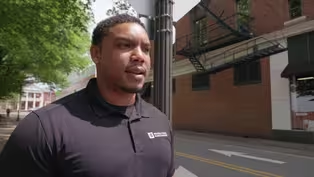VPM News Focal Point
Mapping Segregation’s Impacts
Clip: Season 3 Episode 9 | 4m 14sVideo has Closed Captions
An exhibit shows the impacts of redlining, a discriminatory housing practice, with a series of maps.
An exhibit shows the impact of redlining through a series of maps. The maps show how the discriminatory housing practice has impacts on other factors like wealth and health.
Problems playing video? | Closed Captioning Feedback
Problems playing video? | Closed Captioning Feedback
VPM News Focal Point is a local public television program presented by VPM
The Estate of Mrs. Ann Lee Saunders Brown
VPM News Focal Point
Mapping Segregation’s Impacts
Clip: Season 3 Episode 9 | 4m 14sVideo has Closed Captions
An exhibit shows the impact of redlining through a series of maps. The maps show how the discriminatory housing practice has impacts on other factors like wealth and health.
Problems playing video? | Closed Captioning Feedback
How to Watch VPM News Focal Point
VPM News Focal Point is available to stream on pbs.org and the free PBS App, available on iPhone, Apple TV, Android TV, Android smartphones, Amazon Fire TV, Amazon Fire Tablet, Roku, Samsung Smart TV, and Vizio.
Providing Support for PBS.org
Learn Moreabout PBS online sponsorshipJOHN FINN: This map isn't about whether it's 19% or 21% here.
The map is about, it's different here to here.
I am a self-professed map nerd.
I love working with maps.
I love looking at maps.
I love seeing data visualized in map form, and increasingly in the last couple of years, I've really enjoyed making maps and thinking about how maps can help us to show the public different kinds of social and environmental phenomena.
So the exhibit is called "Living Apart Geography of Segregation in the 21st Century," and it really seeks to answer three basic questions.
Where did the patterns of residential racial segregation in the U.S. originate?
Where did it come from?
What were the processes, the historical, the social, the political processes that led American cities to become so incredibly racially segregated in the 20th century, and then looking into the 21st century, why have those patterns been so durable and what have the effects been in the present day?
We created these 12 different maps.
All 12 maps show exactly the same amount of the city, and they all show the redlined neighborhoods on top, and then they show 12 different sets of data.
And if I've heard one common theme from people who have seen these maps and who have engaged with these maps is that whether you're looking at racial segregation or at poverty or at pavement, or of the lack of tree canopy or urban heat or asthma or life expectancy, it's the same geographical pattern over and over and over.
Basically all these maps, they show 12 different sets of data, but it's always the same pattern.
In my work, my footwork focuses in the Hampton Roads region, north of Virginia Beach, Hampton, Newport News, where I live.
I was invited to come here to the collegiate school in Richmond to do what we're calling a pop-up exhibition where I brought a paired down set of the artifacts from the full gallery exhibition.
We set them up on easels.
We've invited students and classes to come through.
I've had the privilege of talking to four or five different classes about this work through out the day today.
It's basically all the same map, right?
The exhibit begins by getting a little bit into the history of housing segregation in the US and housing discrimination in the US, looking at redlining, looking at public housing policy in the 1940s and 1950s, looking at other housing policies surrounding the suburbanization especially of the American white population, the white middle class suburbanization in the 1950s and the 1960s, all the way through these kind of discrimination and mortgage lending, discrimination and home appraisals, all these different historical processes, both public policy, but also the discriminatory actions of individuals and of companies that created the landscapes of inequality that we inhabit today, New 2022 data shows that median white wealth in the U.S., the middle family, the middle white family in terms of total net worth, has almost $300,000 of wealth.
The median Black family has less than $50,000 of wealth.
And so it's a gap of about 85%.
That 85% gap in wealth between the median white family and the median Black family is I think the single data point that captures the long term and cumulative impact of housing discrimination across the last 100 years.
We closed the exhibit with two parallel ideas of what are cities and municipalities and states around the country doing now to try to redress some of this harm, and what can we as individuals do in order to help improve the situation.
(people chatter)
Video has Closed Captions
Clip: S3 Ep9 | 4m 46s | Community Land Trusts Aim to Innovate for Affordability (4m 46s)
Charlottesville’s new zoning ordinance sparks lawsuit
Video has Closed Captions
Clip: S3 Ep9 | 1m 55s | Charlottesville facing lawsuit as residents sue over newly implemented zoning ordinance (1m 55s)
Community-based solutions to Virginia’s eviction crisis
Video has Closed Captions
Clip: S3 Ep9 | 13m 28s | A United Way pilot program helps families avoid eviction and move out of poverty. (13m 28s)
Harmful history of urban renewal
Video has Closed Captions
Clip: S3 Ep9 | 5m 39s | Many Roanoke residents are still haunted by their memories of urban renewal. (5m 39s)
The metamorphosis of public housing
Video has Closed Captions
Clip: S3 Ep9 | 11m 36s | What was public housing is shifting to affordable housing. Managers lay out the vision. (11m 36s)
New partners in public housing redevelopment
Video has Closed Captions
Clip: S3 Ep9 | 6m 55s | When private donors and public housing residents come together, they find new ways forward (6m 55s)
The promises of public housing
Video has Closed Captions
Clip: S3 Ep9 | 7m 42s | Are those who’ve relied on public housing reaping benefits from redevelopment. (7m 42s)
Revitalizing Martinsville: local man is catalyst for change
Video has Closed Captions
Clip: S3 Ep9 | 3m 33s | A VMI Cadet returns to Martinsville to help revitalize his hometown and mentor others. (3m 33s)
Providing Support for PBS.org
Learn Moreabout PBS online sponsorship
- News and Public Affairs

Top journalists deliver compelling original analysis of the hour's headlines.

- News and Public Affairs

FRONTLINE is investigative journalism that questions, explains and changes our world.












Support for PBS provided by:
VPM News Focal Point is a local public television program presented by VPM
The Estate of Mrs. Ann Lee Saunders Brown
